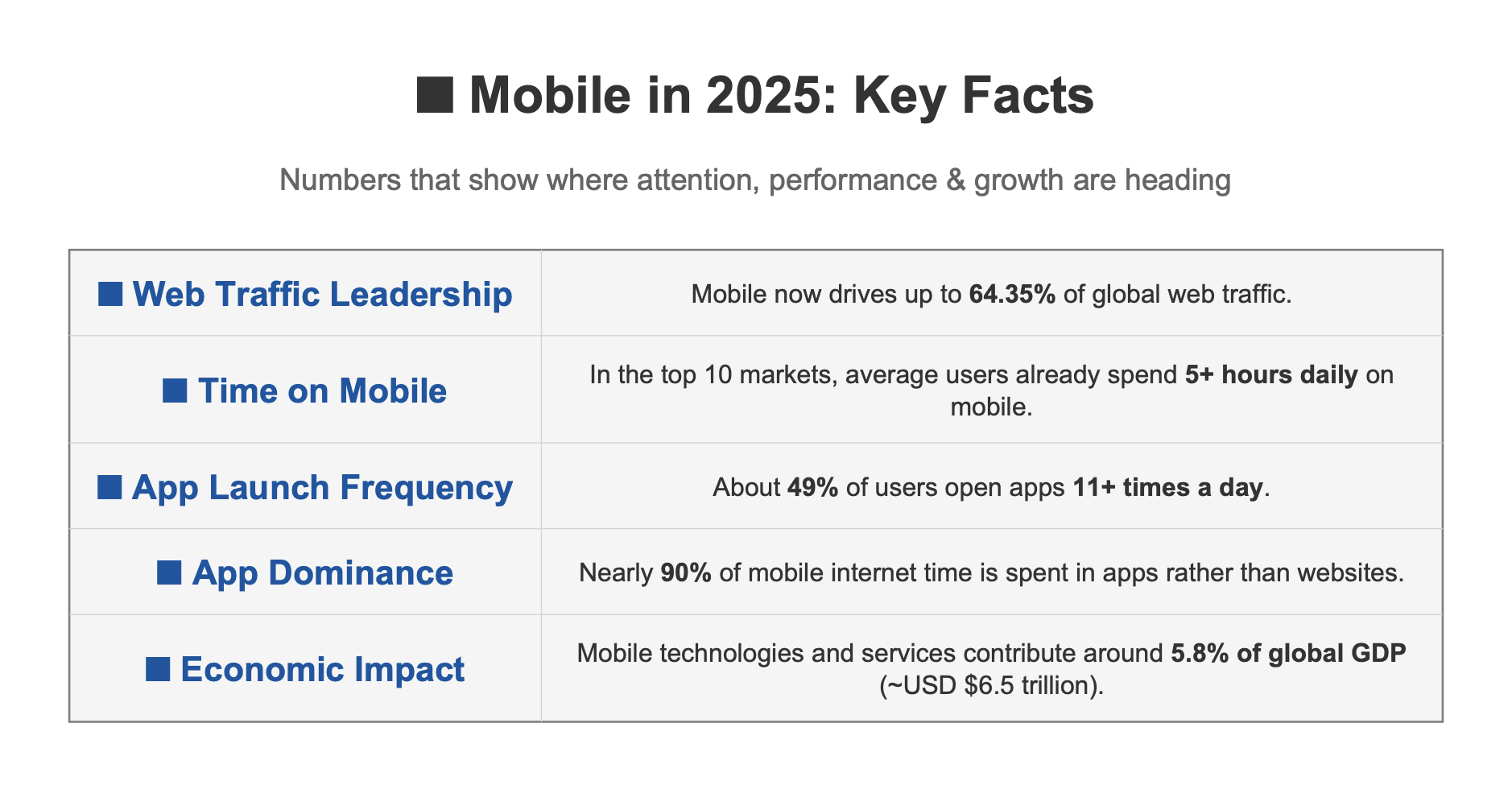Mobile is no longer a competitive edge — it’s the standard. Users expect every serious business to offer a seamless mobile experience, whether through a dedicated app or a progressive web interface. According to eMarketer, mobile remained the leading media platform in 2024, with apps dominating daily use. For companies, this makes mobile the most direct way to capture attention: push notifications, personalized onboarding, and on-device experiences turn apps into constant touchpoints that shape how audiences interact with a brand.

This guide explores where mobile development stands today, the key trends defining the current and coming years, and the practical choices businesses must make to build future-ready mobile experiences.
Today’s Mobile Landscape and the Trends Ahead
Mobile development in 2025 is no longer about “whether” to build apps, but about choosing the right approach in a rapidly evolving ecosystem. Businesses are navigating a mix of established practices and new opportunities — and the trends shaping the next two years point toward faster, smarter, and more flexible mobile experiences.
AI-Native Apps
Generative AI is no longer a side feature — it’s becoming the engine of mobile experiences. Apps are acting like copilots: recommending next steps, creating content, and anticipating user needs. As The Verge notes, AI-focused tools are climbing Apple’s App Store charts across nearly every category. In the first half of 2025, GenAI apps doubled their revenue and grew to 1.7 billion downloads worldwide.
Super Apps vs. Specialized Apps
In Asia, platforms like WeChat and Grab dominate by packing messaging, payments, and shopping into a single hub. In Western markets, users still lean toward specialized apps with focused functionality. This geographic split is forcing developers to choose between depth and breadth in their strategies.
Wearables & Extended Devices
Mobile is expanding beyond the phone. Smartwatches, fitness trackers, and even smart rings are turning into everyday companions, while early AR glasses and connected cars are starting to tie into app ecosystems. Apps designed to integrate with these devices win greater user stickiness.
Immersive Mobile (AR/VR + 5G)
With 5G and edge computing, apps can now support real-time multiplayer gaming, live AR navigation, and ultra-low-latency streaming. What once required heavy desktop infrastructure is now sliding into the palm of the hand.
Together, these trends show that mobile development is moving from static, siloed apps toward adaptive, AI-powered, and device-spanning experiences.
Types of Mobile Apps Today
Every mobile project starts with one question: what kind of app should we build, and for which platforms? With iOS and Android dominating the landscape, businesses have to choose how they want to reach users — and that choice affects cost, performance, and flexibility. From fully native builds to cross-platform frameworks, hybrid shortcuts, and progressive web apps, each approach carries its own advantages and compromises.
Native Apps
Built separately for iOS (Swift, Objective-C) and Android (Kotlin, Java), native apps still set the bar for speed, design flexibility, and full access to device features. They’re the best choice for performance-critical products like gaming, AR, or banking.
Cross-Platform Apps
Frameworks like Flutter, React Native, and Kotlin Multiplatform allow one codebase to power both iOS and Android. They’ve matured into production-ready options, offering near-native performance while reducing time and cost — a sweet spot for businesses that need to move fast.
Hybrid Apps
Using web technologies wrapped in a native shell, hybrid apps offer lower development costs but trade away performance. They can work well for simple, content-driven products, but are less suited for complex, high-interaction experiences.
Progressive Web Apps (PWAs)
PWAs blur the line between websites and apps. Installable from the browser, they offer app-like functionality without the friction of app stores. For businesses testing new ideas or expanding into new regions, PWAs are increasingly attractive as a lean and accessible option.
Guide to the Mobile App Development Process
The way apps are built hasn’t changed at its core — but the priorities in 2025 look different. Teams move faster, leaner, and with more automation than ever before. Generative AI is creeping into the workflow, helping with prototyping, code suggestions, and even UX copy. Meanwhile, testing can’t just mean “does it run on iOS and Android?” — it now includes wearables, voice interfaces, and different screen formats.
Here’s how most modern projects come together today:
- Discovery & Strategy
Nail down the app’s purpose and audience. In 2025, this often includes deciding how AI fits in — as a background feature, or as a core value driver.
- Planning the Build
The old native-vs-cross-platform debate still matters, but now PWAs and low-code tools also enter the conversation. Teams weigh not just cost and performance, but time to market in a fast-shifting environment.
- Designing the Experience
Users expect personalization by default. Dark mode, accessibility, and smooth onboarding aren’t “nice extras” anymore — they’re table stakes.
- Development & Integration
Frameworks have matured, CI/CD pipelines are standard, and integrations extend far beyond payments or analytics. Apps often connect to AI services, IoT devices, or custom APIs that drive differentiation.
- Testing & QA
More devices, more form factors. Emulators help, but real-world testing is crucial — especially for apps that need to perform across wearables, tablets, and different Android versions.
- Launch & Distribution
Stores remain important, but businesses are also experimenting with PWAs for smoother rollouts. A launch plan now blends technical release with marketing hooks, influencer pushes, or AI-driven personalization in onboarding.
- Maintenance & Growth
In 2025, this is where the real work happens: keeping users engaged. Continuous updates, in-app personalization, and real-time analytics decide whether an app survives past its first download spike.
Challenges Businesses Face in Mobile Development
Even with more powerful frameworks and tools, building a successful app in 2025 comes with hurdles that look different from the past. The first is visibility: app stores are oversaturated, and user acquisition costs keep rising. Cutting through the noise now requires more than a marketing budget — it demands creative approaches, from partnerships to ecosystem integration.
Performance is another constant test. Users expect apps to load instantly and work seamlessly across iOS, Android, foldables, and even wearables. Delivering that consistency while juggling fragmented devices and OS versions is one of the toughest parts of development.
Then comes the temptation to overload features. Many businesses add too much too soon, losing clarity in the process. The most successful apps of 2025 are often those that solve one problem brilliantly while still leaving room to grow.
Security also remains a balancing act. Biometrics, encrypted payments, and multifactor authentication are now expected — but if they interrupt the experience, adoption drops fast. Developers need to protect user trust without creating barriers.
And perhaps the hardest challenge of all: retention. A download doesn’t equal success. Keeping users active means thoughtful onboarding, smart push notifications, and personalized engagement that feels relevant, not spammy. It’s a discipline that separates short-lived experiments from long-term winners.
LenGreo helps companies navigate these realities, from finding the right development path to ensuring the finished product is built for performance and user loyalty.
What Mobile Looks Like in Key Industries
The impact of mobile trends becomes clearer when you look at how different industries are putting them into practice:
- B2B platforms are making mobile the default workspace. Sales and CRM apps now integrate AI assistants that prep meeting notes, update pipelines, and even draft outreach on the go. For many professionals, mobile is no longer a backup — it’s the front line of client interaction.
- SaaS companies are shifting from companion apps to full-featured mobile products. Collaboration tools now roll out mobile-first updates, with AI summarizing team activity or predicting bottlenecks, so users can stay productive without a laptop.
- In iGaming, personalization is the differentiator. AI-driven recommendations guide players to games and promotions tailored to their habits, while real-time notifications keep engagement high in fast-moving environments. Compliance and responsible play features are increasingly baked into the core experience.
- For cybersecurity providers, mobile has become a critical channel. Clients expect real-time alerts and the ability to respond instantly, all wrapped in interfaces that balance ease of use with airtight security.
- In the adult industry, apps are evolving around two needs: recruiting creators and engaging users. Mobile-first platforms that integrate flexible payments, real-time interaction, and better safety tools are setting the pace for sustainable growth.
- eCommerce apps are now more than digital storefronts. AI-powered recommendations, one-click payments, and AR try-on features are raising conversion rates and reducing abandoned carts. Mobile has become the main battleground for customer attention in retail.
- In fintech, the app is the bank. From biometric logins to AI-driven financial advice, mobile-first banks are reshaping customer expectations. Traditional institutions are racing to match the seamless, always-available experiences offered by digital challengers.
Looking Ahead: 2026 and Beyond
Mobile is already the default interface for everyday life — and by 2026, it will be even more inseparable from how businesses connect with their audiences. AI will move from a differentiator to a baseline expectation, powering apps that adapt, personalize, and predict in real time. At the same time, the line between Progressive Web Apps and native apps will blur further, giving businesses more flexibility in how they deliver experiences.
But the biggest shift won’t be technical — it will be strategic. Retention and engagement will define success more than downloads, and industries where compliance and trust are critical will face rising expectations for security and transparency. For companies across SaaS, B2B, iGaming, cybersecurity, adult, eCommerce, and fintech, mobile won’t just support growth — it will be the platform that drives it.
LenGreo helps businesses navigate this future by choosing the right development path, creating seamless user experiences, and building mobile strategies that turn today’s challenges into tomorrow’s growth.









